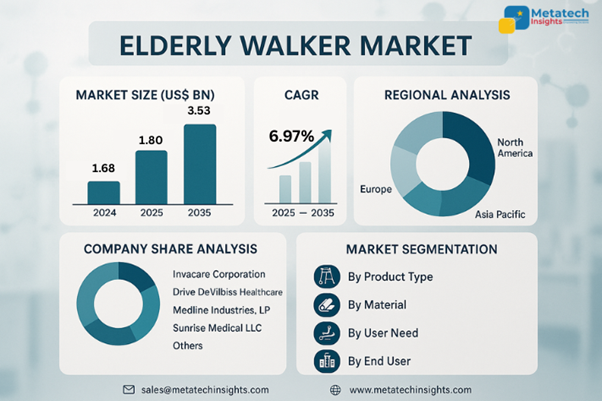Global Elderly Walker Market to Hit USD 3.53 Bn by 2035 | CAGR 6.97%
22 Aug 2025 | Report ID: MI3387 | Industry: Healthcare | Pages: 220 | Forecast Year: 2025-2035

Read more about this report- Global Elderly Walker Market to Hit USD 3.53 Bn by 2035 | CAGR 6.97%
The Elderly Walker Market is valued at USD 1.68 billion in 2024.
The Elderly Walker Market will achieve USD 3.53 billion by 2035 through a projected 6.97% CAGR from 2025 to 2035.
The elderly walker market is relatively stable due to the fact that the number of people who are aware of mobility issues continues to increase among the aging population, the brand-new focus on the safety of the elderly, and the ever-increasing number of people with age-related health problems like arthritis, osteoporosis, and postural disorders. Redesigns, lightweightness, and transportability are influencing the uptake even among different generations. In addition, the development of foldable frames, ergonomic grips, and multiple functions, among other innovations, is supporting the increasing demand for modern-day walkers among consumers.
The product segmentation is based on product type and includes standard walkers, folding walkers, rollators, and specialty walkers. The functionality of rollators (which includes things like built-in seats, storage compartments, and ease of getting around) is becoming quite popular, particularly when used by seniors who are on-the-go and with care facilities. Walkers, as by material, are mainly made of aluminium or steel, or a lightweight alloy combination. The aluminium walkers are more popular in the market because of their portability, rustproof nature, and ease of handling, whereas the walkers made of steel are more popular in the institutional scope of walking because they are stronger and more durable.
User need-based segmentation addresses mobility support, rehabilitation assistance, and fall prevention. Stability, comfort, and ergonomic aids are becoming goals of walkers, especially those who need additional help, with respect to remaining self-sufficient and less susceptible to falls.
The elderly walkers' end-users are separated into individual household consumers and hospitals/rehabilitation centers, and senior care centers. The adoption by households is increasing as the elderly are independent in their everyday operations and the healthcare facilities are using walkers to rehabilitate patients and improve mobility.
Factors that further contribute to the market growth include the rising disposable income and favorable government policy supporting aged care and distribution channels. Constant product developments are promoting uptake both in the developed and emerging territories through lightweight designs, adjustable heights, and foldable structures, among other exciting products. They are also environmentally jump-started by the green materials used therein.
The market geographically covers North America, Europe, Asia Pacific, Latin America, and the Middle East & Africa. North America presently has the greatest market share as a result of great consciousness, good medical infrastructure, and the use of advanced mobility devices. The Asia Pacific is also becoming one of the rapidly growing markets because of the aging population, its urbanization, and the governmental focus on better healthcare and access for the senior population.
The stakeholders that are most likely to influence the Elderly Walker Market are the Invacare Corporation, Drive DeVilbiss Healthcare, Medline Industries, LP, Sunrise Medical LLC, and many other related organizations. To address the changing consumer preferences, there is an increased market presence of these companies through strategic product launches, ergonomic and lightweight factors, the use of sustainable material, and omnichannel distribution planning.
Maximize your value and knowledge with our 5 Reports-in-1 Bundle - over 40% off!
Our analysts are ready to help you immediately.
